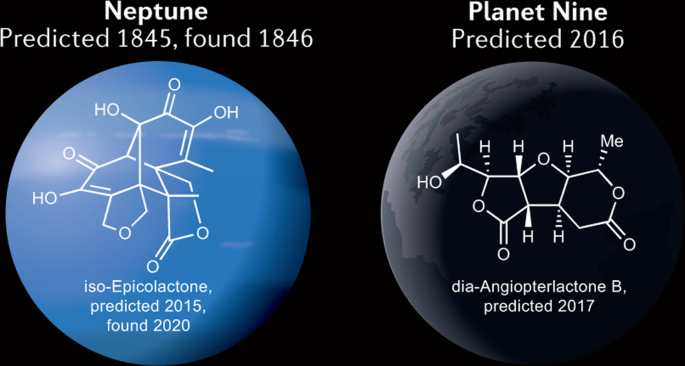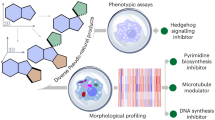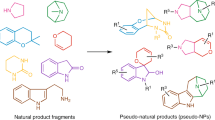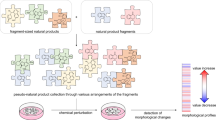Abstract
Natural product synthesis remains one of the most vibrant and intellectually rewarding areas of chemistry, although the justifications for pursuing it have evolved over time. In the early years, the emphasis lay on structure elucidation and confirmation through synthesis, as exemplified by celebrated studies on cocaine, morphine, strychnine and chlorophyll. This was followed by a phase where the sheer demonstration that highly complex molecules could be recreated in the laboratory in a rational manner was enough to justify the economic expense and intellectual agonies of a synthesis. Since then, syntheses of natural products have served as platforms for the demonstration of elegant strategies, for inventing new methodology ‘on the fly’ or to demonstrate the usefulness and scope of methods established with simpler molecules. We now add another aspect that we find fascinating, viz. ‘natural product anticipation’. In this Review, we survey cases where the synthesis of a compound in the laboratory has preceded its isolation from nature. The focus of our Review lies on examples where this anticipation of a natural product has triggered a successful search or where synthesis and isolation have occurred independently. Finally, we highlight cases where a potential natural product structure has been suggested as a result of synthetic endeavours but not yet confirmed by isolation, inviting further collaborations between synthetic and natural product chemists.

This is a preview of subscription content, access via your institution
Access options
Access Nature and 54 other Nature Portfolio journals
Get Nature+, our best-value online-access subscription
$29.99 / 30 days
cancel any time
Subscribe to this journal
Receive 12 digital issues and online access to articles
$119.00 per year
only $9.92 per issue
Buy this article
- Purchase on Springer Link
- Instant access to full article PDF
Prices may be subject to local taxes which are calculated during checkout








Similar content being viewed by others
Change history
22 February 2022
A Correction to this paper has been published: https://doi.org/10.1038/s41570-022-00374-w
References
Nicolaou, K. C. & Snyder, S. A. Chasing molecules that were never there: misassigned natural products and the role of chemical synthesis in modern structure elucidation. Angew. Chem. Int. Ed. 44, 1012–1044 (2005).
Brown, P. D. & Lawrence, A. L. The importance of asking “how and why?” in natural product structure elucidation. Nat. Prod. Rep. 34, 1193–1202 (2017).
Sheehan, J. C. & Henery-Logan, K. R. The total synthesis of penicillin V. J. Am. Chem. Soc. 79, 1262–1263 (1957).
Kuttruff, C. A., Eastgate, M. D. & Baran, P. S. Natural product synthesis in the age of scalability. Nat. Prod. Rep. 31, 419–432 (2014).
Baran, P. S. Natural product total synthesis: as exciting as ever and here to stay. J. Am. Chem. Soc. 140, 4751–4755 (2018).
Trauner, D. Finding function and form. Nat. Prod. Rep. 31, 411–413 (2014).
Gabriel, S. & Pinkus, G. Zur Kenntniss der Amidoketone. Ber. Dtsch. Chem. Ges. 26, 2197–2209 (1893).
Gabriel, S. & Colman, J. Zur Kenntniss des Amidoacetons. Ber. Dtsch. Chem. Ges. 35, 3805–3811 (1902).
Elliott, W. H. Amino-acetone: its isolation and role in metabolism. Nature 183, 1051–1052 (1959).
Willstätter, R. Synthese der Hygrinsäure. Ber. Dtsch. Chem. Ges. 33, 1160–1166 (1900).
Fischer, E. & Abderhalden, E. Ober die verdauung einiger Eiweißkörper durch Pankreasfermente. Biol. Chem. 39, 81–94 (1903).
Willstätter, R. From My Life: The Memoirs of Richard Willstätter (Plunkett Lake, 2016).
Falk, H., Hoornaert, G., Isenring, H.-P. & Eschenmoser, A. Über Enolderivate der Chlorophyllreihe. Darstellung von 132,173-Cyclophäophorbid-enolen. Vorläufige Mitteilung. Helv. Chim. Acta 58, 2347–2357 (1975).
Karuso, P. et al. 132,173-Cyclopheophorbide enol, the first porphyrin isolated from a sponge. Tetrahedron Lett. 27, 2177–2178 (1986).
Ocampo, R., Sachs, J. P. & Repeta, D. J. Isolation and structure determination of the unstable 132, 173-Cyclopheophorbide a enol from recent sediments. Geochim. Cosmochim. Acta 63, 3743–3749 (1999).
Bell, R. A. & Ireland, R. E. The construction of the C/D ring system present in the diterpenoid alkaloids atisine and garryfoline. Tetrahedron Lett. 4, 269–273 (1963).
Church, R. F., Ireland, R. E. & Marshall, J. A. The stereospecific total synthesis of d1-8β-carbomethoxy-13-oxopodocarpane, a degradation product of phyllocladene. Tetrahedron Lett. 1, 1–4 (1960).
Zalkow, L. H. & Girotra, N. N. The synthesis of 5a,8,8-trimethyl-3, 10a-ethanoperhydrophenanthrene. Terpenes. VII. J. Org. Chem. 28, 2037–2039 (1963).
Zalkow, L. H. & Girotra, N. N. Studies in the synthesis of atisine. Terpenes. X. J. Org. Chem. 29, 1299–1302 (1964).
Kapadi, A. H., Sobti, R. R. & Dev, S. The diterpenoids of Erythroxylon monogynum — V atisirene, isoatisirene and devadarene. Tetrahedron Lett. 6, 2729–2735 (1965).
Bonneau, N. et al. An unprecedented blue chromophore found in nature using a “chemistry first” and molecular networking approach: discovery of dactylocyanines A–H. Chem. Eur. J. 23, 14454–14461 (2017).
Fox Ramos, A. E. et al. CANPA: computer-assisted natural products anticipation. Anal. Chem. 91, 11247–11252 (2019).
Medema, M. H. & Fischbach, M. A. Computational approaches to natural product discovery. Nat. Chem. Biol. 11, 639–648 (2015).
Lawrence, A. L. et al. A short biomimetic synthesis of the meroterpenoids guajadial and psidial A. Org. Lett. 12, 1676–1679 (2010).
Yang, X.-L., Hsieh, K.-L. & Liu, J.-K. Guajadial: an unusual meroterpenoid from guava leaves psidium guajava. Org. Lett. 9, 5135–5138 (2007).
Collado, I. G., Hanson, J. R. & Macías-Sánchez, A. J. Recent advances in the chemistry of caryophyllene. Nat. Prod. Rep. 15, 187–204 (1998).
Fu, H.-Z., Luo, Y.-M., Li, C.-J., Yang, J.-Z. & Zhang, D.-M. Psidials A–C, three unusual meroterpenoids from the leaves of Psidium guajava L. Org. Lett. 12, 656–659 (2010).
Tang, G.-H. et al. Psiguajadials A–K: unusual Psidium meroterpenoids as phosphodiesterase-4 inhibitors from the leaves of Psidium guajava. Sci. Rep. 7, 1047 (2017).
Ning, S., Liu, Z., Wang, Z., Liao, M. & Xie, Z. Biomimetic synthesis of psiguajdianone guided discovery of the meroterpenoids from Psidium guajava. Org. Lett. 21, 8700–8704 (2019).
Chen, Y.-Q., Shen, Y.-H., Su, Y.-Q., Kong, L.-Y. & Zhang, W.-D. Incarviditone: a novel cytotoxic benzofuranone dimer from Incarvillea delavayi Bureau et Franchet. Chem. Biodivers. 6, 779–783 (2009).
Brown, P. D., Willis, A. C., Sherburn, M. S. & Lawrence, A. L. Total synthesis of incarviditone and incarvilleatone. Org. Lett. 14, 4537–4539 (2012).
Gao, Y.-P. et al. Incarvilleatone, a new cyclohexylethanoid dimer from Incarvillea younghusbandii and its inhibition against nitric oxide (NO) release. Org. Lett. 14, 1954–1957 (2012).
Novak, A. J. E. & Trauner, D. Reflections on racemic natural products. Trends Chem. 2, 1052–1065 (2020).
Kakinuma, K., Hanson, C. A. & Rinehart, K. L. Spectinabilin, a new nitro-containing metabolite isolated from Streptomyces spectabilis. Tetrahedron 32, 217–222 (1976).
Takahashi, K., Tsuda, E. & Kurosawa, K. SNF4435C and D, novel imimmosuppressants produced by a strain of Streptomyces spectabilis. II. Structure elucidation. J. Antibiot. 54, 548–553 (2001).
Kurosawa, K., Takahashi, K. & Tsuda, E. SNF4435C and D, novel immunosuppressants produced by a strain of Streptomyces spectabilis. I. Taxonomy, fermentation, isolation and biological activities. J. Antibiot. 54, 541–547 (2001).
Beaudry, C. M. & Trauner, D. Total synthesis of (−)-SNF4435 C and (+)-SNF4435 D. Org. Lett. 7, 4475–4477 (2005).
Müller, M. et al. Photochemical origin of the immunosuppressive SNF4435C/D and formation of orinocin through “polyene splicing”. Angew. Chem. Int. Ed. 45, 7835–7838 (2006).
Lindel, T. Chemistry and biology of the pyrrole–imidazole alkaloids. Alkaloids Chem. Biol. 77, 117–219 (2017).
Baran, P. S., O’Malley, D. P. & Zografos, A. L. Sceptrin as a potential biosynthetic precursor to complex pyrrole–imidazole alkaloids: the total synthesis of ageliferin. Angew. Chem. Int. Ed. 43, 2674–2677 (2004).
Northrop, B. H., O’Malley, D. P., Zografos, A. L., Baran, P. S. & Houk, K. N. Mechanism of the vinylcyclobutane rearrangement of sceptrin to ageliferin and nagelamide E. Angew. Chem. Int. Ed. 45, 4126–4130 (2006).
Endo, T. et al. Nagelamides A–H, new dimeric bromopyrrole alkaloids from marine sponge Agelas species. J. Nat. Prod. 67, 1262–1267 (2004).
Brastianos, H. C. et al. Exiguamine A, an indoleamine-2,3-dioxygenase (IDO) inhibitor isolated from the marine sponge Neopetrosia exigua. J. Am. Chem. Soc. 128, 16046–16047 (2006).
Sofiyev, V., Lumb, J., Volgraf, M. & Trauner, D. Total synthesis of exiguamines A and B inspired by catecholamine chemistry. Chem. Eur. J. 18, 4999–5005 (2012).
Volgraf, M. et al. Biomimetic synthesis of the IDO inhibitors exiguamine A and B. Nat. Chem. Biol. 4, 535–537 (2008).
Minato, H. & Horibe, I. Structure and stereochemistry of Xanthumin, a stereoisomer of Xanthinin. J. Chem. Soc. Resumed 1965, 7009–7017 (1965).
Ahmed, A. A., Mahmoud, A. A. & El-Gamal, A. A. A xanthanolide diol and a dimeric xanthanolide from Xanthium species. Planta Med. 65, 470–472 (1999).
Nour, A. M. M. et al. The antiprotozoal activity of sixteen asteraceae species native to Sudan and bioactivity-guided isolation of xanthanolides from Xanthium brasilicum. Planta Med. 75, 1363–1368 (2009).
Wang, L. et al. Cytotoxic sesquiterpene lactones from aerial parts of Xanthium sibiricum. Planta Med. 79, 661–665 (2013).
Feng, J. et al. Enantioselective and collective total syntheses of xanthanolides. Angew. Chem. Int. Ed. 56, 16323–16327 (2017).
Ren, W. et al. Enantioselective and collective syntheses of xanthanolides involving a controllable dyotropic rearrangement of cis-β-lactones. Angew. Chem. Int. Ed. 51, 6984–6988 (2012).
Shang, H. et al. Biomimetic synthesis: discovery of xanthanolide dimers. Angew. Chem. Int. Ed. 53, 14494–14498 (2014).
Brady, S. F., Singh, M. P., Janso, J. E. & Clardy, J. Cytoskyrins A and B, new BIA active bisanthraquinones isolated from an endophytic fungus. Org. Lett. 2, 4047–4049 (2000).
Jadulco, R. et al. New metabolites from sponge-derived fungi Curvularia lunata and Cladosporium herbarum. J. Nat. Prod. 65, 730–733 (2002).
Ejiri, H., Sankawa, U. & Shibata, S. Graciliformin and its acetates in Cladonia graciliformis. Phytochemistry 14, 277–279 (1975).
Yamazaki, H., Koyama, N., Ōmura, S. & Tomoda, H. New rugulosins, anti-MRSA antibiotics, produced by Penicillium radicum FKI-3765-2. Org. Lett. 12, 1572–1575 (2010).
Ogihara, Y., Kobayashi, N. M. & Shibata, S. Further studies on the bianthraquinones of Penicillium islandicum Sopp. Tetrahedron Lett. 9, 1881–1886 (1968).
Nicolaou, K. C., Lim, Y. H., Papageorgiou, C. D. & Piper, J. L. Total synthesis of (+)-rugulosin and (+)-2,2′-epi-cytoskyrin A through cascade reactions. Angew. Chem. Int. Ed. 44, 7917–7921 (2005).
Nicolaou, K. C., Lim, Y. H., Piper, J. L. & Papageorgiou, C. D. Total syntheses of 2,2′-epi-cytoskyrin A, rugulosin, and the alleged structure of rugulin. J. Am. Chem. Soc. 129, 4001–4013 (2007).
Agusta, A., Ohashi, K. & Shibuya, H. Bisanthraquinone metabolites produced by the endophytic fungus Diaporthe sp. Chem. Pharm. Bull. 54, 579–582 (2006).
Manzo, E. et al. New γ-pyrone propionates from the Indian Ocean sacoglossan Placobranchus ocellatus. Tetrahedron Lett. 46, 465–468 (2005).
Cueto, M., D’Croz, L., Maté, J. L., San-Martín, A. & Darias, J. Elysiapyrones from Elysia Diomedea. Do such metabolites evidence an enzymatically assisted electrocyclization cascade for the biosynthesis of their bicyclo[4.2.0]octane core? Org. Lett. 7, 415–418 (2005).
Miller, A. K. & Trauner, D. Mining the tetraene manifold: total synthesis of complex pyrones from Placobranchus ocellatus. Angew. Chem. Int. Ed. 44, 4602–4606 (2005).
Wu, Q. et al. Complex polypropionates from a South China Sea photosynthetic mollusk: isolation and biomimetic synthesis highlighting novel rearrangements. Angew. Chem. Int. Ed. 59, 12105–12112 (2020).
Eccles, R. G. Calycanthine. Drug. Circular Chem. Gaz. 32, 65 (1888).
Steven, A. & Overman, L. E. Total synthesis of complex cyclotryptamine alkaloids: stereocontrolled construction of quaternary carbon stereocenters. Angew. Chem. Int. Ed. 46, 5488–5508 (2007).
Schmidt, M. A. & Movassaghi, M. New strategies for the synthesis of hexahydropyrroloindole alkaloids inspired by biosynthetic hypotheses. Synlett 2008, 313–324 (2008).
Trost, B. M. & Osipov, M. Recent advances on the total syntheses of the communesin alkaloids and perophoramidine. Chem. Weinh. Bergstr. Ger. 21, 16318–16343 (2015).
Xu, J.-B. & Cheng, K.-J. Studies on the alkaloids of the calycanthaceae and their syntheses. Molecules 20, 6715–6738 (2015).
May, J. A. & Stoltz, B. The structural and synthetic implications of the biosynthesis of the calycanthaceous alkaloids, the communesins, and nomofungin. Tetrahedron 62, 5262–5271 (2006).
Dotson, J. J., Bachman, J. L., Garcia-Garibay, M. A. & Garg, N. K. Discovery and total synthesis of a bis(cyclotryptamine) alkaloid bearing the elusive piperidinoindoline scaffold. J. Am. Chem. Soc. 142, 11685–11690 (2020).
Hall, E. S., McCapra, F. & Scott, A. I. Biogenetic-type synthesis of the calycanthaceous alkaloids. Tetrahedron 23, 4131–4141 (1967).
Gavagnin, M., Mollo, E., Cimino, G. & Ortea, J. A new γ-dihydropyrone-propionate from the Caribbean sacoglossan Tridachia crispata. Tetrahedron Lett. 37, 4259–4262 (1996).
Sharma, P., Lygo, B., Lewis, W. & Moses, J. E. Biomimetic synthesis and structural reassignment of the tridachiahydropyrones. J. Am. Chem. Soc. 131, 5966–5972 (2009).
Gavagnin, M., Mollo, E. & Cimino, G. Is phototridachiahydropyrone a true natural product? Rev. Bras. Farmacogn. 25, 588–591 (2015).
Bister, B. et al. Abyssomicin C — A polycyclic antibiotic from a marine Verrucosispora strain as an inhibitor of the p-aminobenzoic acid/tetrahydrofolate biosynthesis pathway. Angew. Chem. Int. Ed. 43, 2574–2576 (2004).
Nicolaou, K. C. & Harrison, S. T. Total synthesis of abyssomicin C, atrop-abyssomicin C, and abyssomicin D: implications for natural origins of atrop-abyssomicin C. J. Am. Chem. Soc. 129, 429–440 (2007).
Nicolaou, K. C. & Harrison, S. T. Total synthesis of abyssomicin C and atrop-abyssomicin C. Angew. Chem. Int. Ed. 45, 3256–3260 (2006).
Keller, S. et al. Abyssomicins G and H and atrop-abyssomicin C from the marine Verrucosispora strain AB-18-032. J. Antibiot. 60, 391–394 (2007).
Ellerbrock, P., Armanino, N., Ilg, M. K., Webster, R. & Trauner, D. An eight-step synthesis of epicolactone reveals its biosynthetic origin. Nat. Chem. 7, 879–882 (2015).
Yan, Z. et al. Fused multicyclic polyketides with a two-spiro-carbon skeleton from mangrove-derived endophytic fungus Epicoccum nigrum SCNU-F0002. RSC Adv. 10, 28560–28566 (2020).
Greshock, T. J. & Williams, R. M. Improved biomimetic total synthesis of d,l-stephacidin A. Org. Lett. 9, 4255–4258 (2007).
Qin, W.-F. et al. Total synthesis of (−)-depyranoversicolamide B. Chem. Commun. 51, 16143–16146 (2015).
Xu, X., Zhang, X., Nong, X., Wang, J. & Qi, S. Brevianamides and mycophenolic acid derivatives from the deep-sea-derived fungus Penicillium brevicompactum DFFSCS025. Mar. Drugs 15, 43 (2017).
Crombie, L. & Ponsford, R. Synthesis of (±)-deoxybruceol. Chem. Commun. Lond. 1968, 368a (1968).
Crombie, L. & Ponsford, R. Pyridine-catalysed condensation of citral with phloroglucinols, a novel reaction leading to tetracyclic bis-ethers and chromenes. Two-step synthesis of (±)-deoxybruceol. J. Chem. Soc. C Org. 1971, 788–795 (1971).
Ghisalberti, E. L. et al. Structural studies in the bruceol system. J. Chem. Soc. Perkin Trans. 2, 583–589 (1981).
Day, A. J., Sumby, C. J. & George, J. H. Biomimetic synthetic studies on the bruceol family of meroterpenoid natural products. J. Org. Chem. 85, 2103–2117 (2020).
Harada, N. et al. Total synthesis, absolute configuration, and later isolation of (−)-prehalenaquinone, a putative biosynthetic precursor to the marine natural products: halenaquinone and xestoquinone. J. Org. Chem. 59, 6606–6613 (1994).
Matsuura, B. S., Kölle, P., Trauner, D., de Vivie-Riedle, R. & Meier, R. Unravelling photochemical relationships among natural products from Aplysia dactylomela. ACS Cent. Sci. 3, 39–46 (2017).
Kotammagari, T. K., Gonnade, R. G. & Bhattacharya, A. K. Biomimetic total synthesis of angiopterlactone B and other potential natural products. Org. Lett. 19, 3564–3567 (2017).
Nicolaou, K. C., Sanchini, S., Wu, T. R. & Sarlah, D. Total synthesis and structural revision of biyouyanagin B. Chem. Eur. J. 16, 7678–7682 (2010).
Löbermann, F., Mayer, P. & Trauner, D. Biomimetic synthesis of (−)-pycnanthuquinone C through the Diels–Alder reaction of a vinyl quinone. Angew. Chem. Int. Ed. 49, 6199–6202 (2010).
Ma, D., Liu, Y. & Wang, Z. Biomimetic total synthesis of (±)-homodimericin A. Angew. Chem. Int. Ed. 56, 7886–7889 (2017).
Stichnoth, D. et al. Photochemical formation of intricarene. Nat. Commun. 5, 5597 (2014).
Brown, P. D. & Lawrence, A. L. Total synthesis of millingtonine. Angew. Chem. Int. Ed. 128, 8421–8425 (2016).
Brown, P. D., Willis, A. C., Sherburn, M. S. & Lawrence, A. L. Total synthesis and structural revision of the alkaloid incargranine B. Angew. Chem. 125, 13515–13517 (2013).
Purgett, T. J., Dyer, M. W., Bickel, B., McNeely, J. & Porco, J. A. Gold(I)-mediated cycloisomerization/cycloaddition enables bioinspired syntheses of neonectrolides B–E and analogues. J. Am. Chem. Soc. 141, 15135–15144 (2019).
Novak, A. J. E., Grigglestone, C. E. & Trauner, D. A biomimetic synthesis elucidates the origin of preuisolactone A. J. Am. Chem. Soc. 141, 15515–15518 (2019).
Li, H., Korotkov, A., Chapman, C. W., Eastman, A. & Wu, J. Enantioselective formal syntheses of 11 nuphar alkaloids and discovery of potent apoptotic monomeric analogues. Angew. Chem. Int. Ed. 55, 3509–3513 (2016).
Breunig, M., Yuan, P. & Gaich, T. An unexpected transannular [4+2] cycloaddition during the total synthesis of (+)-norcembrene 5. Angew. Chem. Int. Ed. 59, 5521–5525 (2020).
Nicolaou, K. C., Chen, Q., Li, R., Anami, Y. & Tsuchikama, K. Total synthesis of the monomeric unit of lomaiviticin A. J. Am. Chem. Soc. 142, 20201–20207 (2020).
Zheng, K., Shen, D., Zhang, B. & Hong, R. Landscape of lankacidin biomimetic synthesis: structural revisions and biogenetic implications. J. Org. Chem. 85, 13818–13836 (2020).
Su, S., Seiple, I. B., Young, I. S. & Baran, P. S. Total syntheses of (±)-massadine and massadine chloride. J. Am. Chem. Soc. 130, 16490–16491 (2008).
Strych, S. et al. Biomimetic total synthesis of santalin Y. Angew. Chem. Int. Ed. 54, 5079–5083 (2015).
Gao, Y. et al. Isolation and biomimetic synthesis of (±)-guajadial B, a novel meroterpenoid from Psidium guajava. Org. Lett. 14, 5936–5939 (2012).
Yang, B. et al. Asymmetric total synthesis and biosynthetic implications of perovskones, hydrangenone, and hydrangenone B. J. Am. Chem. Soc. 143, 6370–6375 (2021).
Long, X., Wu, H., Ding, Y., Qu, C. & Deng, J. Biosynthetically inspired divergent syntheses of merocytochalasans. Chem 7, 212–223 (2021).
Acknowledgements
B.E.H. thanks New York University for a MacCracken fellowship. The authors thank B. S. Matsuura for helpful discussions. The authors thank B. S. Matsuura, A. J. E. Novak and K.-P. Rühmann for their critical review of the manuscript.
Author information
Authors and Affiliations
Contributions
The authors contributed equally to all aspects of the article.
Corresponding authors
Ethics declarations
Competing interests
The authors declare no competing interests.
Additional information
Peer review information
Nature Reviews Chemistry thanks J. George and the other, anonymous, reviewer(s) for their contribution to the peer review of this work.
Publisher’s note
Springer Nature remains neutral with regard to jurisdictional claims in published maps and institutional affiliations.
Rights and permissions
About this article
Cite this article
Hetzler, B.E., Trauner, D. & Lawrence, A.L. Natural product anticipation through synthesis. Nat Rev Chem 6, 170–181 (2022). https://doi.org/10.1038/s41570-021-00345-7
Accepted:
Published:
Issue Date:
DOI: https://doi.org/10.1038/s41570-021-00345-7
This article is cited by
-
Plants against cancer: towards green Taxol production through pathway discovery and metabolic engineering
aBIOTECH (2024)
-
Nature-inspired micropatterns
Nature Reviews Methods Primers (2023)
-
Collective total synthesis of C4-oxygenated securinine-type alkaloids via stereocontrolled diversifications on the piperidine core
Nature Communications (2022)



